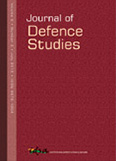Conflict and Cooperation in India-China Relations
India-China relations, though occasionally showing signs of peace and cooperation, have often been afflicted by tension and mistrust. With the potential to make big contributions to regional peace and development, these two Asian powers have, by design or accident, themselves been the sources of regional tension and insecurity to some extent. Besides their internal dynamics, the interplay of interests and moves of their neigbours, and several external powers would have significant bearing on the equation and relations between them.
- J.K. Baral |
- April 2012 |
- Journal of Defence Studies




